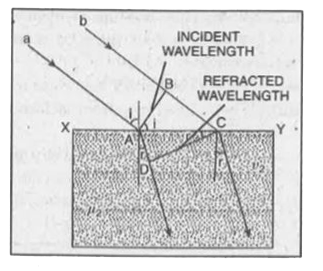Huygens wave theory is used
Video Solution
Text Solution
Laws of refraction
First law of refraction. Let XY be a plane refracting surface and AB be a plane wavefront incident on the surface as shown in the figure.

According to Huygens. principle, every point on wavefront AB is a source of secondary wavelets and the time during which wavelet from B reaches C, the refracted wavelet from A would arrive at D.
i.e. t=BCv1=ADv2 ...(i)
where v1 is the velocity of light in medium 1 and v2 is the velocity of light in medium II.
Eq (i) can be written as
BCAD=v1v2 ...(ii)
In rt ∠ΔABC,
sini=BCAC
or BC = AC sin i
Similarly in rt ∠ΔADC,
AD = AC sin r
So Eq (ii) becomes
ACsiniACsinr=v1v2=cv1cv2=cv2.v1c
or sinisinr=μ2μ1=μ
This is Snell.s law and is called first law of refraction.
Second law of refraction. From the figure, we find that, the incident ray and the refracted ray and the normal at the point of incidence, all lie in the same plane XY. This proves second law of refraction.
|
Topper's Solved these Questions
- OPTICSBOOK - MBD -HARYANA BOARDCHAPTER - OPTICSEXERCISE - LONG ANSWER TYPE QUESTIONS
18 Videos
- OPTICSBOOK - MBD -HARYANA BOARDCHAPTER - OPTICSEXERCISE - OBJECTIVE TYPE QUESTIONS
26 Videos
- OPTICSBOOK - MBD -HARYANA BOARDCHAPTER - OPTICSEXERCISE - OBJECTIVE TYPE QUESTIONS
26 Videos
- MODEL TEST PAPER - 2BOOK - MBD -HARYANA BOARDCHAPTER - MODEL TEST PAPER - 2EXERCISE - SET - D ( LONG ANSWER TYPE QUESTIONS)
4 Videos
- PRINCIPLES OF COMMUNICATIONBOOK - MBD -HARYANA BOARDCHAPTER - PRINCIPLES OF COMMUNICATIONEXERCISE - Objective Type Questions
19 Videos
Similar Questions
Knowledge Check
Huygens wave theory allows us to know
A(a) The wavelength of the waveB(b) The velocity of the waveC(c) The amplitude of the waveD(d) The propagation of wavefrontsHuygen’s wave theory allows us to know :
Athe wavelength of the waveBthe velocity of the waveCthe amplitude of the waveDthe propagation of wavefronts.In Huygen's wave theory, the locus of all points in the same state of vibration is called :
AA half period zoneBOscillatorCA wave-frontDA ray
